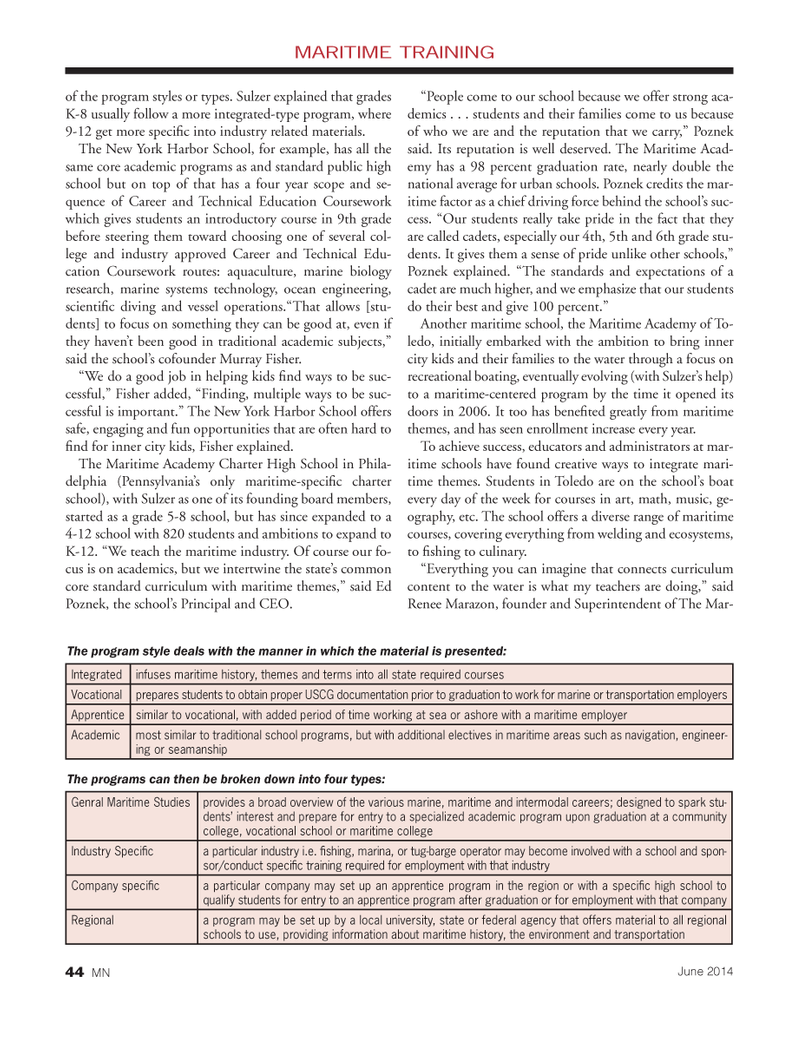
Page 44: of Marine News Magazine (June 2014)
Dredging & Marine Construction
Read this page in Pdf, Flash or Html5 edition of June 2014 Marine News Magazine
of the program styles or types. Sulzer explained that grades K-8 usually follow a more integrated-type program, where 9-12 get more speciÞ c into industry related materials. The New York Harbor School, for example, has all the same core academic programs as and standard public high school but on top of that has a four year scope and se- quence of Career and Technical Education Coursework which gives students an introductory course in 9th grade before steering them toward choosing one of several col- lege and industry approved Career and Technical Edu- cation Coursework routes: aquaculture, marine biology research, marine systems technology, ocean engineering, scientiÞ c diving and vessel operations.ÒThat allows [stu- dents] to focus on something they can be good at, even if they havenÕt been good in traditional academic subjects,Ó said the schoolÕs cofounder Murray Fisher. ÒWe do a good job in helping kids Þ nd ways to be suc- cessful,Ó Fisher added, ÒFinding, multiple ways to be suc- cessful is important.Ó The New York Harbor School offers safe, engaging and fun opportunities that are often hard to Þ nd for inner city kids, Fisher explained. The Maritime Academy Charter High School in Phila- delphia (PennsylvaniaÕs only maritime-speciÞ c charter school), with Sulzer as one of its founding board members, started as a grade 5-8 school, but has since expanded to a 4-12 school with 820 students and ambitions to expand to K-12. ÒWe teach the maritime industry. Of course our fo- cus is on academics, but we intertwine the stateÕs common core standard curriculum with maritime themes,Ó said Ed Poznek, the schoolÕs Principal and CEO. ÒPeople come to our school because we offer strong aca- demics . . . students and their families come to us because of who we are and the reputation that we carry,Ó Poznek said. Its reputation is well deserved. The Maritime Acad- emy has a 98 percent graduation rate, nearly double the national average for urban schools. Poznek credits the mar- itime factor as a chief driving force behind the schoolÕs suc- cess. ÒOur students really take pride in the fact that they are called cadets, especially our 4th, 5th and 6th grade stu- dents. It gives them a sense of pride unlike other schools,Ó Poznek explained. ÒThe standards and expectations of a cadet are much higher, and we emphasize that our students do their best and give 100 percent.Ó Another maritime school, the Maritime Academy of To- ledo, initially embarked with the ambition to bring inner city kids and their families to the water through a focus on recreational boating, eventually evolving (with SulzerÕs help) to a maritime-centered program by the time it opened its doors in 2006. It too has beneÞ ted greatly from maritime themes, and has seen enrollment increase every year. To achieve success, educators and administrators at mar- itime schools have found creative ways to integrate mari- time themes. Students in Toledo are on the schoolÕs boat every day of the week for courses in art, math, music, ge- ography, etc. The school offers a diverse range of maritime courses, covering everything from welding and ecosystems, to Þ shing to culinary. ÒEverything you can imagine that connects curriculum content to the water is what my teachers are doing,Ó said Renee Marazon, founder and Superintendent of The Mar- MARITIME TRAININGIntegratedinfuses maritime history, themes and terms into all state required courses Vocationalpr epares students to obtain proper USCG documentation prior to graduation to work for marine or transportation employers Apprenticesimilar to vocational, with added period of time working at sea or ashore with a maritime employer Academicmost similar to traditional school programs, but with additional electives in maritime areas such as navigation, engine er-ing or seamanshipThe program style deals with the manner in which the material is presented:Genral Maritime Studiesprovides a broad overview of the various marine, maritime and intermodal careers; designed to spark stu- dents? interest and prepare for entry to a specialized academic program upon graduation at a community college, vocational school or maritime collegeIndustry Speci ca par ticular industry i.e. shing, marina, or tug-barge operator may become involved with a school and spon- sor/conduct speci c training required for employment with that industry Company speci ca particular company may set up an apprentice program in the region or with a speci c high school to qualify students for entry to an apprentice program after graduation or for employment with that company Regionala program may be set up by a local university, state or federal agency that offers material to all regional schools to use, providing information about maritime history, the environment and transportation The programs can then be broken down into four types: June 201444 MNMN June14 Layout 32-49.indd 44MN June14 Layout 32-49.indd 445/20/2014 10:24:20 AM5/20/2014 10:24:20 AM

 43
43

 45
45
